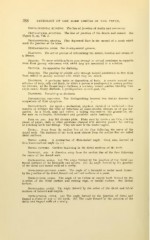Page 440 - My FlipBook
P. 440
288 PATHOLOGY OF THE HAED TISSUES OF THE TEETH.
Dento-cemental junction. The line of junction of dentin and cementum.
Dento-enamel junction. The line of junction of the dentin and enamel. See
Figure 8, de, Vol. 2.
Developmental grooves. Fine depressed lines in the enamel of a tooth which
mark the junction of its lobes.
Developmental lines. See developmental grooves.
Diagnosis. The art or process of determining the nature, location and causes of
a disease.
Dialvze. To cause soluble salts to pass through an animal membrane to separate
them from gummy substances with which they are associated in a solution.
Dializer. An apparatus for dializing.
Dialysis. The passing of soluble salts through animal membranes to free them
from colloid or gummy material with which they are mixed.
Diathesis. A particular habit or disposition of body. A certain natural con-
stitution of body, cells and fluids, by which a person is predisposed to certain particu-
lar diseases ; as the Hemorrhagic diathesis, a tendency toward profuse bleeding from
slight cause ; Gouty diathesis, a predisposition toward gout, etc.
Diathetic. Pertaining to diathesis.
Differential diagnosis. The distinguishing between two similar diseases by
comparison of their symptoms. •
Disinfectant. An agent — mechanical, physical, chemical or medicinal — that
removes or destroys the virus of infectious or communicable diseases or of pus for-
mation. As a brush, soap and water; a boiling temperature, the germicides, etc.
See note on antiseptic, disinfectant and germicide under Antiseptic.
Disk or disc. Any flat circular plate. Disks used by dentists are thin, circular
pieces of paper, cloth or other substance charged With abrasive powder for cutting
or polishing teeth and fillings. They are used in the dental engine.
Distal. Away from the median line of the face following the curve of the
dental arch. The surfaces of the teeth most distant from the median line are called
distal surfaces.
Distal angle. A contraction of disto-incisal angle. Used, also, instead of
disto-bucco-occlusal angle (q. v.)
Distal cavities. Cavities beginning in the distal surfaces of the teeth.
Distally. adv. A direction away from the median line of the face following
the curve of the dental arch.
Disto-buccal angle, (a) The angle formed by the junction of the distal and
buccal surfaces of the bicuspids and molars, (b) An angle formed by the junction
of the distal and buccal walls of a cavity.
Disto-bucco-occlusal angle. The angle of a bicuspid or molar tooth formed
by the junction of its distal, buccal and occlusal surfaces at a point.
Disto-incisal angle. The angle of an incisor or cuspid tooth formed by the
junction of the distal surface and cutting edge, or incisal surface. See Incisal
surface.
Disto-labial angle. The angle formed by the union of the distal and labial
surfaces of incisors and cuspids.
Disto-lingual angle, (a) The angle formed by the junction of distal and
lingual surfaces of any of the teeth, (b) The angle formed by the junction of the
distal and lingual walls of a cavity.


